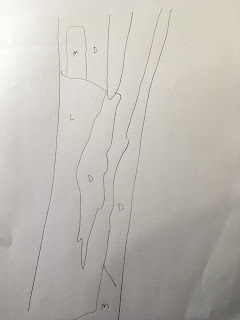Drawing 2 #5
-Need good quality largish photo of a tree- preferably black and white
1. Review homework
a. Animal drawing.
b. Tree: Your homework was to
c. find or take a tree photo (close enough to see the texture of the tree),
d. draw thumbnails to plan a simple composition focusing on the tree trunk, but have interest in the positive and negative spaces,
2. Tree drawing:
a. To believably draw a tree, you need to:
1) First outline the shape of the trunk and branches.
2) Next look at the value patterns (lightness and darkness) underneath the texture. You can see them better if you squint your eyes and blur the details. Outline the different value areas.
3) Bark texture is indicated by using marks that imitate bark shape and a suggestion of texture that our mind interprets. You don’t have to draw the texture in great detail but use the stokes that convey the feel:
-Slightly wandering line that convey a feel of bark grooves.
-Cross-hatches
Check out this web site: https://pendrawings.me/how-to-draw-tree-trunks/
a. Look at samples... Think of a theme, then anything goes, but I will ask you about your composition choices- Consider emphasis, simplicity, variety and harmony:
1) Variety: Using different shapes, lines, colors, and textures to create interest.
2) Harmony: Using similar shapes, lines, colors, and textures to help the design hold together.
b. Tips:
1) Supports: Try a mat board, canvas board, davey board, cardboard, hardboard
2) Match textures of paper- rice paper, sketch paper, etc. -aim for an even texture and a well-blended piece.
3) UHU glue sticks, acrylic medium
4. Homework
a. Tree- finish.
b. Collage- have fun.
c. New portrait- We will start a face in a simple line style such as those by Picasso and Matisse (see samples). Choose a photo of a face you like.




Comments
Post a Comment